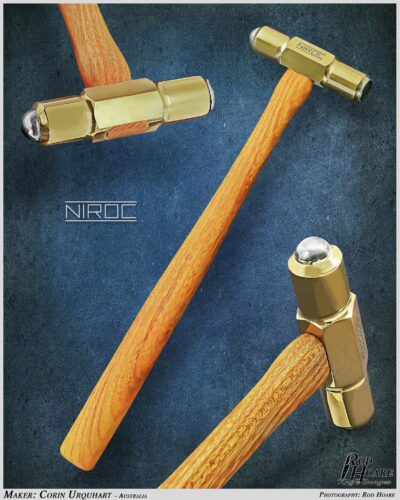Why use a tungsten carbide hammers for blade straightening?
I started making knives in around 2002 from blade blanks however it was not until later that I started to heat treat myself. One of the most frustrating things about heat treating is blade warpage. There are many ways to correct a warped blade however all of these methods have negative effects. For example the risk of cracks or breakage, need to be done at elevated temperatures, or directly after quench before martensite forms, Take excessive amounts of time or trial and error.
In 2019 I had somewhat of a revelation when ABS Mastersmith Rodrigo Sfreddo came to Australia for the awesome Australian Blade Symposium and masterclass in keyhole handled knives. During his demonstration Rodrigo made the comment that a bent blade is not difficult to correct post heat treat and when we scoffed he produced a small ballpeen hammer and a bent blade and proceeded to tap on it with the curve such that the ends were up. This astonished us but what astonished all that were there even more was just how quickly the bend corrected. The secret we were informed was that the hammer needed to be small and hard and the taps numerous and light.
At first I, like many people I was sceptical as to the effects of this technique on hardened steel, however having now done it many times myself and seen several of the worlds most respected bladesmiths and knifemakers use the technique, I am satisfied that the method is not only valid, but by far the best post heat treat blade straightening technique I have used.
Whilst it is true that a hardened ball peen will work (though it will require regular redressing) and you can use a domed tungsten carbide drill bit or tool improvised to do this, I am a custom knifemaker and I love cool tools. It is nice to have a hand made tools specifically to do a job. For this reason I started making these hammers. I also started making them with a carbide flat face. I have not seen anyone make a hammer with a carbide flat face before but this has two great advantages.
- Being brass bodied (denser than steel) and and having twice the Tungsten Carbide, (about 1.8 times denser than steel) The hammer is much heavier than its volume would suggest. A small heavy hammer is ideal for this work.
- The Carbide flat face is exceptional for riveting pins and even hardened tangs. In fact it is exceptional for many tasks common to the knifemaker, where a small heavy, hard hammer is a good solution.
In fact these hammers have a wide range of uses outside of knifemaking and they are prised by toolmakers, jewellery makers, watchmakers, woodworkers, saw doctors and general makers that appreciate the advantages of these hammers over normal steel ball peens.
I ship hammers most working days and take pride in everything I make. If you are looking for a custom hammer for a specific purpose, particularly custom tungsten carbide hammers, consider my interest already piqued and reach out please I would be happy to hear the conundrum and maybe develop the solution!

